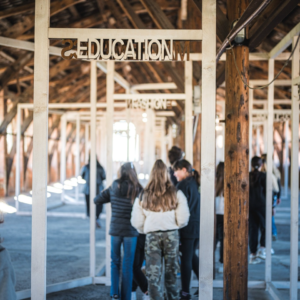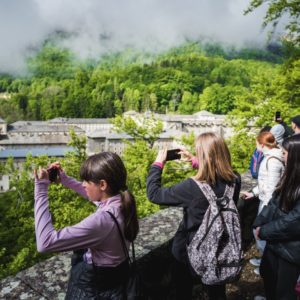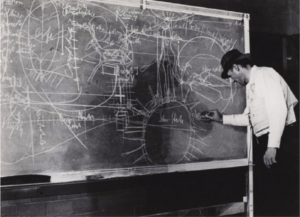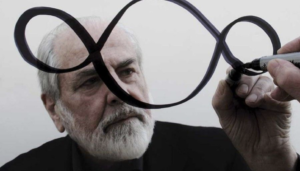Borrowing some thoughts from Yona Friedman, the visionary artist/architect and urban planner who passed away in 2020, we can define both the city and the school as “realised utopias”, i.e. imagined dreams, projected forward, then designed and built step by step by a humanity long since extinct. Dreams/utopias that have become real habits for us, fundamental parts of our common living, hence realised utopias. But who dreamt these utopias? Through the institution of the city school, primitive humanity managed to give itself social and economic stability, creating a civil organisation of reference, a body not only of laws but of moral, intellectual and spiritual meanings recognisable to most. City and school effectively transformed the thinking and body of humanity, which gradually selected what was necessary for the coexistence of large groups on a common land space. Neither the city nor the school have, therefore, always existed in the albeit brief history of mankind, but were dreamt up by that human group that imagined stopping in one place and coexisting.

Students participating in the project “Archipelago Explorers”.
Photo: Francesco Ferraro Titin.
Even when the school is in the mountains or in a forest, the routines of the city remain implicit, such as entering the school, marking time, the parents’ pick up at the end of the day. The school is, in fact, the DNA of the city and within its invariable part we can trace the fundamental information, the cultural equipment to remake the city. This is why over time the school has also been instrumentalised and forced to channel the education of ‘citizens’ into a political-economic totalitarian ideology. The school determines the city, even when it seems distant. Where there is no school, the city melts and vanishes, it moves elsewhere, to another school, to another city. This brief premise of the city-school binomial is to say that if one imagines and proposes a new idea of city, one necessarily works for a new idea of school. Imagining a city-archipelago that encompasses the greenery, that extends to the rivers and hills, that makes the previously isolated forces and businesses of a territory complement each other, inevitably leads to rethinking the boundaries of the school in that territory, taking its perimeter of action outside the walls of the classrooms. Freeing the city from its former boundaries presupposes freeing the school from its conventional perimeters.

Students participating in the project “Archipelago Explorers”.
Photo: Francesco Ferraro Titin.
In 2021, Cittadellarte’s Learning Environments and Education Office launched the experimentation of a parental school developed in collaboration with Associazionedidee, a civic learning space called the Open School of the Third Paradise. This is not a space created with the sole intention of teaching, but a prototype where ‘doing school’ is interpreted in its etymological sense of giving school a new form, organised and yet not conventional. But if school and city are a pair, creating a new learning environment is not possible without the help of all those organisations that act manifesting a community and educational vocation. There are many institutions that have already embarked on a path of regeneration, but still lacking is a path of tuning, i.e. of attunement, to bring them together in a territorial planning process. If the didactic apparatus and the civic apparatus are therefore inseparable, there is a third element that connects them, which is the spiritual apparatus, that is, the tension that human beings have in producing a ‘super nature’, a virtual world projected forward, where utopia is located and realised. On this plane of imagination, which we often unconsciously call the future, are the most varied and creative possibilities that today’s little boys and girls manifest at school. In the school’s present lies the future of the city.
Going back to the city/school binomial, which we should at this point reverse to school/city, those who attend classrooms daily know that the school reflects society like a mirror, made by generation after generation of students. In fact, the school mirror returns to us all the contrasts, drives, desires that animate and move contemporary society and sometimes tries to dissolve them into a synthesis, a conventional system of norms and forms that can find the approval of the majority of citizens. Training and education are also drastic actions that are not always attentive to individual sensitivities because they are more considerate of the general framework in which to place people, instilling an idea of civilisation, civic education, sometimes a specific ideology.


First image: Joseph Beuys drawing on the blackboard at the Düsseldorf Art Academy, 1961-1975.
Second image: Michelangelo Pistoletto tracing the Third Paradise on a mirror. Photo: Juan Sandoval, 2010.
Awareness of the creative fact within the school is the dividing line between an institution that risks sterilising the complex thinking that the new generations bring with them and one that organises it. The effects of sterilisation are evident when thinking becomes passive and withdraws from contradiction, to the point of shutting oneself away in the private rooms of one’s home, a phenomenon evident in cases of hikikomori, people who choose to limit their social life by resorting to extreme levels of isolation. If the school is a space of creation, then it is the most radical political laboratory there can be, the laboratory of the ‘polis’, that is, of the city in its classical sense. If the invention of society had the utilitarian purpose of facilitating survival, that of the schoolhad the purpose of handing down behaviours, which are not natural, but made up by human beings. How then to balance the relationship between the different natural aspirations of each individual and the impersonal and artificial aspirations of the community (which in itself has no will or purpose of its own)? The only thing that can help is the construction of fluid and connected community places where the autonomous expression of each person is enhanced within a simple organisational framework in which the exercise of dialogue is a daily occurrence and the community path can innervate the city. We have a responsibility to bring the school into every environment, every time we sit down at the table with someone and cross the threshold of convention, every time we start a dialogue and the teachers take turns, there we are making school, we are making the polis, and refounding a city full of creative differences, where ‘you and I’ make the ‘we’.

